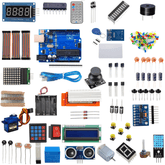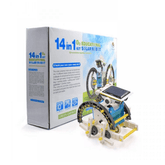Robotics Engineering: What is it and Types
Summary
Explore the cutting-edge world of Robotics Engineering in our latest blog! Uncover the essence of Robotics in Artificial Intelligence, delving into the 'Why' and 'What' behind this exciting field. Discover the pivotal role of Robotics Engineers, the path to becoming one, and the seamless integration of Robotics and Automation. We'll also unveil the diverse branches within Robotics, providing a comprehensive overview. Ready to embark on a journey into the future? Read on to decode the realm of Robotics Engineering!
Introduction
Robotics is an expansive field of engineering and technology focused on the design, construction, and operation of robots. Robots are programmed machines capable of carrying out complex series of actions with little to no human input. The integration of robotics across various industries has revolutionized automation, augmenting human capabilities in unprecedented ways. From constructing precision manufactured goods to performing delicate surgical procedures, robots are being deployed for an ever-growing range of applications. The importance of robotics continues to rise as the technology becomes more sophisticated and accessible.
Robots excel in roles that may be unsuitable, dangerous, or inefficient for human workers. Their mechanical nature allows them to operate tirelessly in hazardous environments like nuclear power plants, space exploration missions, and underwater construction projects. Robots can take over repetitive and tedious tasks in factories or warehouses that humans find unstimulating. Their ability to maintain uninterrupted productivity with extreme precision boosts outputs and minimizes errors. Advances in artificial intelligence, motion sensors, manipulators, and neural networks are pushing robotics towards even greater capabilities. As a result, robots are streamlining operations and enhancing safety across aviation, healthcare, agriculture, security, and more. The study of robotics offers the opportunity to shape the future of automation and its integration for the betterment of society.
What is Robotics in Artificial Intelligence?

Robotics represents an application domain of artificial intelligence concerned with empowering machines to perceive, reason, and act upon the physical world. While AI focuses broadly on training systems to mimic human cognition, robotics focuses on embedding such intelligence in mechanical devices. Robotics integrates AI developments like machine learning, neural networks, computer vision, natural language processing, knowledge representation, motion planning and more to construct robots capable of operating intelligently, independently, and adaptively.
AI algorithms in robotics translate sensor data into usable representations, select appropriate responses and actions, and refine behavior through trial-and-error learning. This artificial intelligence grants robots the ability to comprehend vocal commands, recognize objects, map unfamiliar terrain, respond to anomalies in real time, and make situationally appropriate decisions without human oversight. AI transforms rigid automatons into dynamic systems that can adapt to varied contexts and challenges in human-like ways. It facilitates complex behavior like locate and grasp objects, navigate through crowds, respond politely to inquiries, and comply with safety protocols.
The fusion of AI and robotics sciences is producing robots with growing autonomy. As algorithms improve, less explicit programming is required for robots to exhibit intelligent conduct in open-ended real-world scenarios. Robotics strives to mimic elements of human cognition like memory, reasoning, planning, and problem solving for multi-functional versatility. Advancing artificial intelligence that can be transferred to different robotic platforms remains central to creating widely capable and useful intelligent machines.
Why Robotics?

There are compelling technological, economic and humanitarian reasons propelling robotics to the forefront of innovation. Robotics possesses numerous advantages over relying solely on human operators. Robots excel in tasks that are dangerous, repetitive, require great accuracy and consistency, or need superhuman capabilities. Their mechanical accuracy and tireless operation enables mass-production, enhanced safety, and exploration of extreme environments well beyond human physical limits.
Robots can assume monotonous and hazardous jobs that jeopardize human well-being like handling toxic materials, defusing bombs, mining, or exploring harsh terrain. Unlike humans, robots can perform repetitive factory work continuously without tiring or becoming bored by the tedium. Integrating robotic systems into manufacturing bolsters speed, precision, and output volumes. Robots also enable micro-scale production tolerances and consistency unattainable manually for items like computer chips.
For highly precise medical interventions like neurosurgery or retinal microsurgery, a robotic surgeon steadies instruments and scales down movements to sub-millimeter accuracy. This allows otherwise impossible procedures that augment human abilities. Robotic caretakers can lift and support invalids with steady and tireless assistance. Through such applications, robotics protects and enhances human health and safety.
Exploring distant planets, handling nuclear materials, or cleaning up oil spills all pose dangers exceedingly hard to shield people from. Yet robots can be specifically engineered to withstand such conditions. Space probes like the Mars rovers uncover the mysteries of alien worlds no human could yet reach. Robotics is enabling scientific advances and pushing the horizons of human understanding.
What Does a Robotics Engineer Do?

Robotics engineers conceptualize, design, simulate, prototype, test, and deploy robotic mechanisms and systems. They creatively integrate principles from electrical, mechanical, and software engineering to construct innovative robots. While some robotics engineers work in research roles pioneering new technologies, others are directly involved in producing commercial robots.
A robotics engineer begins by analyzing needs and specifying requirements for a robotic solution. This involves strategically identifying the optimal mechanical structure, actuators, energy sources, materials, sensors, controls, and AI capabilities suited for an application. Roboticists then use computer-aided design software to model prototype designs and simulate functionality. Next, physical prototypes are built and optimized through iterative testing.
Vital skills for a robotics engineer include programming proficiency to code the software governing robot actions and responses. This can involve artificial intelligence techniques like neural networks, fuzzy logic, and evolutionary algorithms that allow robots to learn. Mathematical and analytical abilities are needed to develop motion planning algorithms and vision processing solutions. Strong background knowledge in electrical circuits, microprocessors, actuators, transmitters, power systems, and embedded systems enables creating robotic components. Understanding design and mechanical engineering principles is key for constructing the physical structure. Troubleshooting abilities help diagnose and refine prototypes.
Once a robot design is finalized, robotics engineers oversee manufacturing plans and quality assurance. They establish end-user requirements and interfaces so the robot can be operable. Robotics engineers also provide ongoing maintenance to maximize the working lifespan of robotic systems.
How to Become a Robotics Engineer
Aspiring robotics engineers should pursue an undergraduate degree in engineering such as robotics, mechatronics, electrical, aerospace, mechanical, or software engineering. Useful minors include computer science, mathematics, design, and business. A well-rounded engineering foundation across multiple domains is ideal preparation. Hands-on course projects in prototyping designs, using CAD modeling tools, and programming microcontrollers will cultivate practical robot building skills.
Gaining internship experience at university research labs or robotics companies provides invaluable real-world experience. Student teams that compete in robotics challenges offer networking opportunities. Graduates wanting to refine expertise further may pursue a Master's degree specializing in robotics.
When recruiting, companies seek strong programming abilities, so developing fluency in languages like Python, C++, MATLAB, and Linux is key. Having project examples that showcase technical skills provides an advantage. Math proficiency, analytical skills, creativity, and passion for generating innovative solutions are essential.
Communication and teamwork abilities are also vital in this highly collaborative, interdisciplinary field. Lifelong learning to stay abreast of technological advances will keep one's skills relevant. Overall, the most skilled robotics engineers combine broad-based engineering knowledge with adaptable problem-solving.
What is Robotics and Automation?

While closely linked, robotics and automation have distinct focuses. Robotics concentrates on constructing intelligent, programmable machines that can actively sense, process sensory information, and manipulate objects. Automation means replacing human operators with automated systems to complete work processes. It minimizes the need for human effort and supervision to produce and deliver goods.
Industrial automation utilizes control systems and information technologies to automate equipment like assembly lines. It increases accuracy and output over manual methods. Integrating robotics expands the scope of automation. Intelligent robots can automate a wider range of tasks like transporting materials, quality inspection, and predictive equipment maintenance. Their sensor-based adaptability and decision making enable dynamic responses unachievable through static automation alone.
Robotic automation combines the precision, speed, and reliability of automated equipment with the flexibility and intelligence of robots that react and learn. Together, robotics and automation enable optimized, self-regulating production flows. As robotics continues advancing, it will pave the way for fully automated factories and facilities requiring little ongoing human oversight.
Various Types/Branches of Robotics
Robotics is a highly multi-disciplinary field encompassing several specialized branches:
- Industrial robotics: Stationary or mobile robots assisting in manufacturing, warehousing, material handling, and logistics. Common across assembly lines.
- Mobile robotics: Robots capable of locomoting across diverse terrains. Used for inspection, transportation, surveillance etc.
- Medical robotics: Surgical robots, prosthetics, exoskeletons, and robotic aids that enhance healthcare.
- Bio-robotics: Robots inspired by biological structures and phenomena present in nature.
- Swarm robotics: Coordinating large numbers of relatively simple robots to accomplish tasks.
- Soft robotics: Robots constructed from compliant materials that better handle delicate objects.
- Space robotics: Robots suited to withstand and work in the harsh conditions of space. Critical for space exploration.
- Nano-robotics: Microscopic scale robots smaller than a millimeter programmed to manipulate tiny objects or travel through the bloodstream.
- Lego robotics: Robots constructed from lego components to introduce younger students to robotics in a fun, interactive way.
- Home automation and consumer robotics: Robotic technology aimed for domestic use like automated vacuum cleaners, lawnmowers, toys, and assistants.
- Aerial robotics: Unmanned Aerial Vehicles (UAVs) and drones capable of flight and navigating through air autonomously.
- Marine robotics: Robotic submarines, boats, and amphibious vehicles that operate on or under water. Used for ocean exploration and seabed mapping.
Conclusion
Robotics is an expansive and multi-faceted field driving automation to new heights across industries. Integrating robotics enhances manufacturing, healthcare, scientific exploration, infrastructure maintenance, defense, and more while reducing human risk. As artificial intelligence advances, robots are becoming more adaptive, intelligent, and autonomous. Robotics engineers work at the cutting edge to make such automation technologies safe, useful, and collaborative. The future points towards even smarter robotic systems that can cooperate with humans as co-workers and assistants. Robotics promises to extend human capabilities in ways we are only beginning to imagine.










